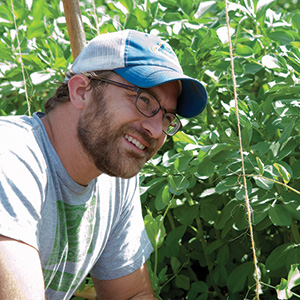

Zach Lewis crouches down and unsheathes a knife-like tool from his hip. He digs up a wild fennel sprout from the outer edge of a raised-bed garden lush with fava beans and fringed with upward-creeping pea vines.
“It’s a hori hori,” he explains, displaying the glinting half-spade, half-soil-measuring stick. “Some type of Japanese tool. It looks scary, but it’s really useful.”
On this warm weekend morning he wields it to unearth weeds that sprang up with the inaugural bean crop on what he calls Taylor Street Farm, an acre-small pocket of land bordered by a thoroughfare, a Citibank parking lot and a line of row houses. Cars zip around the western perimeter from the Highway 87 Taylor Street off-ramp. The occasional low-flying jetliner roars in the clear sky overhead, still gaining air from takeoff at San Jose’s nearby airport.
“If you don’t know it’s here, it’s easy to miss,” remarks Lewis, a tall, sandy-haired 30-year-old with a laborer’s build.
To the soundtrack of passing engines, he tends the plot he fought six months to acquire. A year ago, as a San Jose State University urban planning grad student, he began lobbying for a zoning change, asking the city to allow farming on up to an acre of industrial and commercial land—in the thick of a city where nutritious food is hard to come by.
In an October vote, the City Council obliged. By the end of the month, Lewis secured a deal with developer Barry Swenson, who agreed to lease a lot that had sat empty for years, accumulating trash along its outer edge. Volunteers helped raise the hoop-houses and hammer together boards for the planter boxes.
“It was a triple win,” Lewis says. “I got land to farm, the property owner doesn’t have to worry about blight and the city gets positive PR out of the whole thing—bragging rights and another community garden.”
One of many more to come, Lewis hopes.
If his Taylor Street experiment goes as planned, his nonprofit Garden to Table will grow enough food to grace the menus of restaurants—starting with Blackbird Tavern, which agreed to buy Lewis’ winter greens—and make enough money to fund the organization’s charitable efforts. Part of Garden to Table’s mission is teaching needy families how to farm and collecting backyard fruit for the Second Harvest Food Bank.
“We’ll see how this works out,” he says. “I’m optimistic, because we have gotten so much support from the city. I think elected officials and people in general are starting to realize more the value of locally sourced food and how that fits into urban life.”



